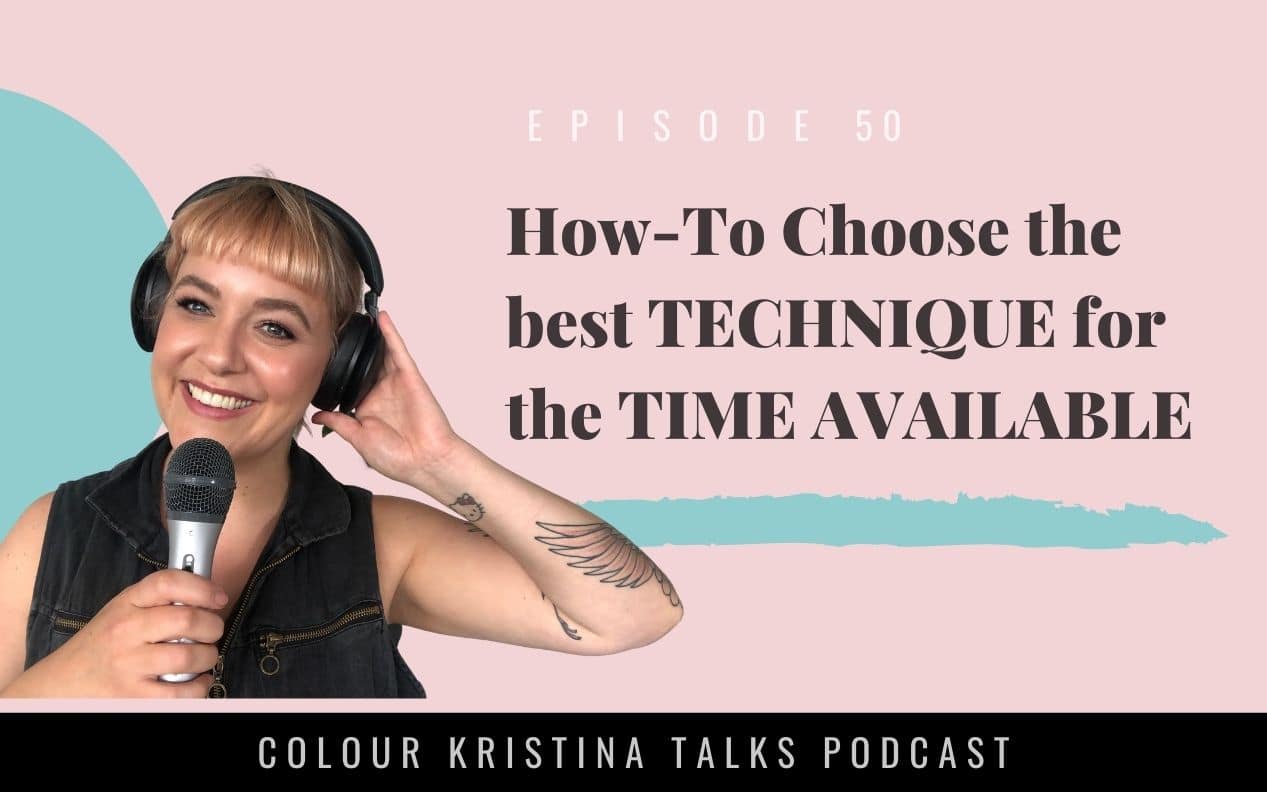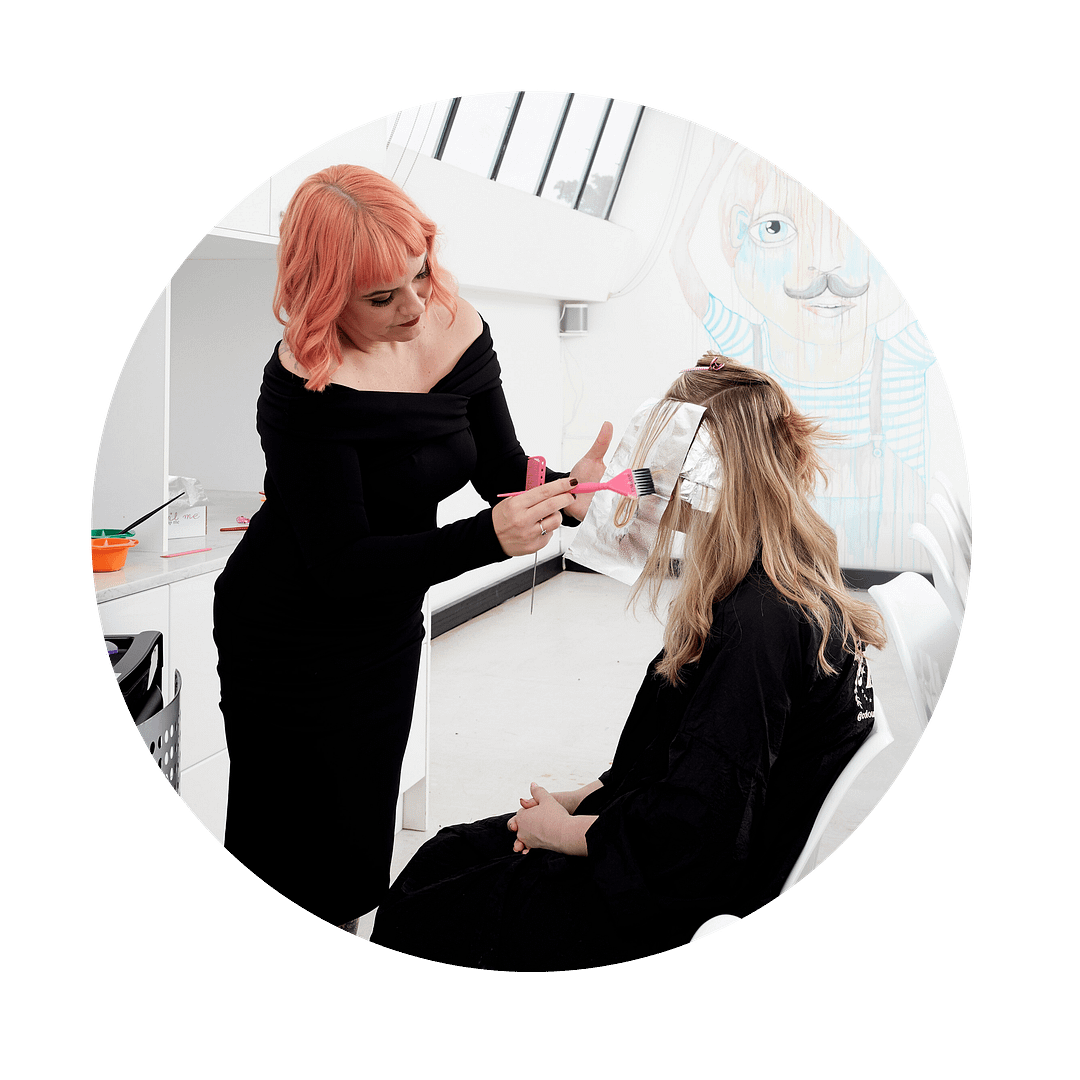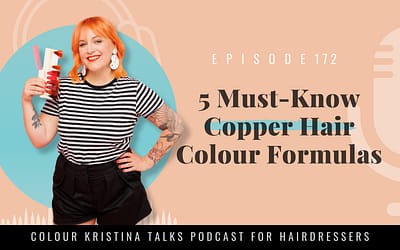
Episode 50
How-To Choose the best TECHNIQUE for the TIME AVAILABLE

What I'll be talking about
In this episode of the Colour Kristina Talks Podcast, we’re talking about technique timing strategy and why you need one.
Choosing the best technique for the time available in your day to day salon life is a skill that will set you up for success. I don’t mean that you need to speed up for success. I do understand that in some salons being the fastest is considered being the best… and to some extent that could be true, but rest assured I am certainly not the fastest colourist and never will be. I am not trying to be.
However many of my clients comment on how fast I am. One of my strengths is that I choose techniques to please clients within the time we have available. This was drilled into me during my training 20 years ago & was something I would be scored on every week within our internal training days. We were not only assessed on hair colour technique, formulas and end results. There was just as much importance at the business side of colouring so that we could operate as a professional hairdresser that knew how to maximise their day within the boundaries of what was physically possible. This meant maximising revenue, earnings, rebookings and revisits and so much more.
Show notes for the podcast episode 50
hairdressers must have a technique timing strategy for success
I am going to share with you my exact process around decision making from a consultation based on the time available on the clock. There are 4 key themes discussed in this podcast;
1. Client walks in and you want them to leave the salon happy. This is always the goal, right?
- Clients will be happy if they are listened to
- Clients will be happy if they have been advised by a professional what is and isn’t possible in their hair vision, both short and long term
- Clients don’t always know what technique to ask for, so it is important that the Hairdresser offers what the client needs and what the Hairdresser has time to create
- Take charge and suggest what you can do & not just offer what they are asking
2. Know your technique service menu timings and offer your time accordingly
- Let me break this down for you – sit down with your price list or service menu soon and note down the timing you need for each service. Work through this with care and patience. Be real. Don’t write down 45 minutes for a ½ head foils if you know you always need longer, especially if you are including wearing PPE and providing additional services like cleaning and perhaps you’re now working 1:1 in your salon's covid recovery. Prices and service times need to be adjusted accordingly to what your salon reality is.
- I know it takes me about 1 hour to paint my ½ head foils, but I allow 90 minutes to book this in. I do this because I like to do long consultations so that I really understand the client's vision. I also need time to put their cape on and mix colours and make a decision for foil angles & formula & setup tools needed for this process. So I need 90 minutes for a ½ head but it’s broken down into more than just my foiling time, which means if I had a client chatting to me and the time on the clock read 60 minutes I would need to offer a smaller service.
3. I understand that sometimes it’s hard to step away from a client and start painting when under time pressure. This is when you need to rein it in and take back control of the situation.
Here are a few ideas you could try saying in this situation;
- “I understand that you are wanting to go lighter with extra brightness around the face. I would love to get started so I can maximise our time together”
- “I have 60 minutes with you and really want to paint your hair, so let me go mix my colours up and come back to chat further about your hair cut and styling while we begin the process”
- Or if not clear and I am losing clarity I say something like, “I am sorry I am becoming more confused with our consultation, so I am going to extend our consultation time to make sure we are both on the same page. Is that ok with you?” (and then in your head you must be thinking about a relevant technique in the new time frame that will be less if you extend the consultation)
4. The 3 biggest benefits of knowing the best technique for the time available is that you
- Running on time
- Can offer a professional and customised approach for every client
- You avoid burnout

Links and resources
link to @colourkristinatalkspodcast
link to kristina russell facebook page
Leave a review
If you enjoyed this episode, I have a favour. Please take two minutes to subscribe and write a rating and review. You can do that on Apple Podcasts right now by clicking here. If you are an android user, you can follow the podcast on Spotify here. These actions will help my podcast reach more people, and I would be truly grateful. Thank you so much.
Recent
podcasts
EP 172: The 5 Must-Know Copper Formulas for Every Brand You Need to Know
Wondering if Chat GPT can help you formulate haircolour? In this episode, we answer that question.
EP 171: Balayage & Toning Tips for Red and Copper Hair Clients
In this episode, I'll be talking about balayage and toning strategies for redheads and why they are so different to working with Blondes, Brondes and Brunettes.
EP 170 [EXPIRING EPISODE]: HOW TO ACHIEVE COPPER HAIR MASTERCLASS REPLAY
Learn:
How to formulate Reds and Coppers in the salon using the 5-6-7-8 levelling system that works with every single hair colour brand
How to avoid the 2 biggest mistakes Hairdressers make when colouring reds and copper Haircolour
The secret to hair painting “natural” tones in Reds and Coppers when a client requests classic tones as opposed to high-fashion hair colours or vivid tones
Strategies to boost your confidence to attract new clients to your salon seeking red hair colour – even if you're a total newbie, an experienced hairdresser that is scared of making costly mistakes or you’re avoiding reds altogether
EP 169: Chat GPT Prompts to help you formulate hair colour.
Wondering if Chat GPT can help you formulate haircolour? In this episode, we answer that question.





![EP 170 [EXPIRING EPISODE]: HOW TO ACHIEVE COPPER HAIR MASTERCLASS REPLAY](https://mlonhhjeqfif.i.optimole.com/cb:Hmjb.fb7/w:400/h:250/q:mauto/rt:fill/g:sm/f:best/https://kristinarussell.com.au/wp-content/uploads/2023/10/EP-153.png)
